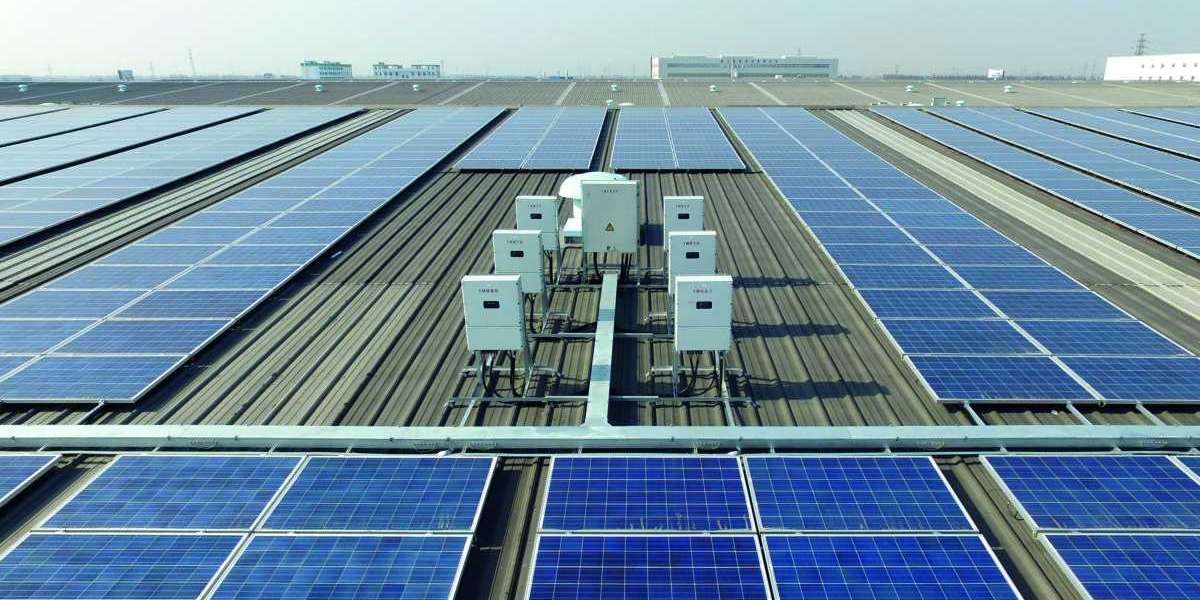The Pakistan Solar Inverter Market is witnessing significant growth as the country focuses on expanding its renewable energy capacity, particularly solar power, to meet increasing energy demands and reduce its reliance on conventional fossil fuels. Solar inverters are an essential component of solar energy systems, converting direct current (DC) electricity generated by solar panels into alternating current (AC) electricity, which can be used by homes, businesses, and industries. As Pakistan continues to prioritize renewable energy projects and sustainable power generation, the role of solar inverters becomes even more critical. This article explores the trends, drivers, challenges, and opportunities shaping the Pakistan Solar Inverter Market.
In recent years, Pakistan has been making strides in its transition to clean energy, with solar power becoming one of the most promising alternatives to traditional energy sources. The Pakistan Solar Inverter Market is expected to experience rapid growth, fueled by government policies, falling costs of solar equipment, and increasing environmental awareness among consumers and businesses. This article provides an in-depth analysis of the market's current state, future outlook, and key factors driving the adoption of solar inverters across the country.
Market Overview
The solar inverter market in Pakistan is driven by the growing demand for renewable energy solutions as the country faces energy shortages, power outages, and environmental challenges. Pakistan has vast solar energy potential, particularly in the southern and southwestern regions, which experience high levels of sunlight throughout the year. This abundance of sunlight, combined with decreasing costs of solar panels and inverters, has made solar energy a viable option for both residential and commercial installations.
Growth Drivers
Several key factors are driving the growth of the Pakistan Solar Inverter Market:
Government Policies and Incentives
The Pakistani government has introduced a range of policies and incentives to encourage the adoption of renewable energy technologies. The Alternative Energy Development Board (AEDB) and the National Electric Power Regulatory Authority (NEPRA) have been actively promoting solar energy through net metering, tax exemptions, and subsidies. These initiatives are making solar power systems, including solar inverters, more affordable and accessible to a wider segment of the population.Rising Energy Demand and Load Shedding
Pakistan has faced a chronic energy crisis, with power shortages and frequent load shedding affecting businesses, industries, and households. Solar power provides an attractive solution to these issues, offering a reliable and independent energy source. Solar inverters play a crucial role in enabling households and businesses to harness solar energy efficiently, leading to a surge in demand for solar inverter systems.Falling Costs of Solar Equipment
The cost of solar panels and inverters has decreased significantly over the past decade due to advances in technology, economies of scale, and increased global production. This reduction in prices has made solar installations more affordable for both residential and commercial customers in Pakistan. As a result, the demand for solar inverters has risen in tandem with the growing adoption of solar energy systems.Environmental Awareness and Sustainability Goals
With increasing awareness of environmental issues and the need for sustainability, more Pakistani consumers and businesses are turning to solar energy as a clean and renewable energy source. Solar inverters, which help maximize the efficiency of solar power systems, are a crucial part of these sustainable energy solutions. The growing concern about climate change and the desire to reduce carbon footprints are pushing the demand for solar technology, including inverters.
Market Challenges
Despite the growth prospects, the Pakistan Solar Inverter Market faces several challenges that may hinder its progress:
Lack of Infrastructure and Technical Expertise
The solar energy sector in Pakistan still faces challenges related to infrastructure and technical expertise. While there is a growing market for solar installations, the lack of skilled technicians and service providers capable of installing and maintaining solar inverters can pose a barrier to widespread adoption. Additionally, the lack of proper grid infrastructure in certain regions of the country can limit the effective integration of solar energy systems.High Initial Investment Costs
While the cost of solar inverters and panels has decreased, the initial investment required for a complete solar energy system (including installation and inverter costs) can still be relatively high. This remains a significant barrier for many residential consumers and small businesses in Pakistan, particularly in rural areas. Although the long-term savings on electricity bills can offset these upfront costs, many potential customers are deterred by the initial financial outlay.Regulatory and Policy Challenges
Despite government incentives, the regulatory environment for solar energy in Pakistan can be complex and inconsistent. There are challenges related to grid integration, permitting processes, and interconnection requirements for solar power systems. The lack of clear and streamlined regulations for solar inverter installation can delay projects and create uncertainty for investors and consumers alike.
Types of Solar Inverters in Pakistan
The solar inverter market in Pakistan is diverse, with different types of inverters catering to various needs and applications. The most common types of solar inverters in Pakistan include:
1. String Inverters
String inverters are the most widely used type of solar inverter in Pakistan. These inverters are typically used in residential and small commercial solar systems. A string inverter converts DC power from a series of solar panels (a string of panels) into AC power. While string inverters are cost-effective and easy to install, their efficiency can be affected by shading, dirt, or faults in a single panel within the string.
2. Microinverters
Microinverters are becoming increasingly popular for residential solar installations in Pakistan. Unlike string inverters, microinverters are installed on each individual solar panel, allowing for independent panel operation. This results in higher efficiency, especially in installations where shading or orientation issues may reduce the performance of certain panels. Microinverters are more expensive than string inverters but offer better performance in challenging conditions.
3. Central Inverters
Central inverters are typically used in large-scale commercial or industrial solar installations. These inverters are more powerful and are capable of handling high volumes of electricity. Central inverters are ideal for utility-scale solar projects, where large arrays of solar panels are used. In Pakistan, central inverters are being deployed in solar farms and large commercial projects aimed at addressing the country’s energy shortage.
4. Hybrid Inverters
Hybrid inverters are gaining traction in Pakistan, particularly in off-grid and grid-tied solar systems with energy storage. These inverters are designed to work with both solar panels and batteries, allowing users to store excess energy for later use. Hybrid systems are particularly beneficial in areas where grid reliability is poor, as they provide a backup power source during outages.
Key Players in the Pakistan Solar Inverter Market
The Pakistan Solar Inverter Market is highly competitive, with both local and international companies offering a range of inverter solutions. Some of the key players in the market include:
Sungrow Power Supply Co. Ltd.
Sungrow is a leading global provider of solar inverters, and it has a significant presence in Pakistan. The company offers a range of string inverters, central inverters, and hybrid solutions, with a focus on high efficiency and durability.Fronius International GmbH
Fronius is known for its high-quality inverters and has been a strong player in the Pakistani market, particularly for residential and commercial applications. The company offers advanced inverter solutions with features like monitoring and grid management.Huawei Technologies Co. Ltd.
Huawei is a major supplier of smart solar inverters, with a focus on high-performance and intelligent energy management. The company’s solar inverters are used in both residential and commercial solar systems across Pakistan.SMA Solar Technology AG
SMA is a well-known brand in the solar inverter industry, offering a wide range of products suitable for various applications, from residential to large-scale commercial installations. SMA inverters are widely used in Pakistan’s solar energy projects.
Opportunities in the Pakistan Solar Inverter Market
The Pakistan Solar Inverter Market presents numerous opportunities for growth, particularly in the following areas:
Rural Electrification Projects
With the large rural population in Pakistan lacking reliable access to electricity, solar energy provides an excellent opportunity for off-grid electrification. Solar inverters can play a pivotal role in these rural electrification projects, which can be supported by government incentives and international funding.Commercial and Industrial Solar Installations
The increasing adoption of solar power in commercial and industrial sectors offers significant opportunities for solar inverter manufacturers. Businesses looking to reduce energy costs and carbon footprints are investing in large-scale solar systems, creating a growing demand for high-efficiency inverters.Smart Solar Technologies
The rise of smart technologies in the energy sector presents an opportunity for the development and deployment of advanced solar inverters with features like remote monitoring, real-time performance analysis, and grid stabilization. These features are highly attractive to both residential and commercial customers in Pakistan.Solar Energy Storage Solutions
The integration of solar inverters with battery storage systems is becoming increasingly important in Pakistan, particularly in areas where grid stability is a concern. Hybrid inverters, which can manage both solar generation and battery storage, present an exciting growth area in the market.
Conclusion
The Pakistan Solar Inverter Market is on a promising growth trajectory, fueled by increasing demand for renewable energy, government incentives, and technological advancements in solar power systems. With the country’s vast solar potential and the growing need for sustainable energy solutions, solar inverters will play a crucial role in enabling Pakistan's transition to a greener future. Despite challenges such as high initial costs and regulatory hurdles, the market offers significant opportunities for growth, particularly in rural electrification, commercial solar adoption, and smart inverter technologies. As Pakistan continues to prioritize solar energy, the solar inverter market is set to play a pivotal role in the nation’s energy transformation.
More Trending Reports







